Plantation complexes in the Southern United States

Plantation complexes in the Southern United States refers to the built environment (or complex) that was common on agricultural plantations in the American South from the 17th into the 20th century. The complex included everything from the main residence down to the pens for livestock. A plantation originally denoted a settlement in which settlers were "planted" to establish a colonial base. Southern plantations were generally self-sufficient settlements that relied on the forced labor of slaves, similar to the way that a medieval manorial estate relied upon the forced labor of serfs.[1]
Today, as was also true in the past, there is a wide range of opinion as to what differentiated a plantation from a farm. Typically, the focus of a farm was subsistence agriculture. In contrast, the primary focus of a plantation was the production of cash crops, with enough staple food crops produced to feed the population of the estate and the livestock.[2] A common definition of what constituted a plantation is that it typically had 500 to 1,000 acres (2.0 to 4.0 km2) or more of land and produced one or two cash crops for sale.[3] Other scholars have attempted to define it by the number of slaves that were owned.[4]

The vast majority of plantations did not have grand mansions centered on a huge acreage. These large estates did exist, but represented only a small percentage of the plantations that once existed in the South.[2] Although many southern farmers did own slaves prior to emancipation, few owned more than five. These farmers tended to work the fields alongside their slaves. Of the estimated 46,200 plantations known to exist in 1860, 20,700 had 20 to 30 slaves and only 2,300 had a workforce of a hundred or more, with the rest somewhere in between.[4]
Many plantations operated by absentee-landowners never had a main house on site. Just as vital and arguably more important to the complex were the many structures built for the processing and storage of crops, food preparation and storage, sheltering equipment and animals, and various other domestic and agricultural purposes. The value of the plantation came from its land and the enslaved people (later sharecroppers or tenants) who toiled on it to produce crops for a profit. These same people produced the built environment, from the main house for the plantation owner, the slave cabins, barns, and other structures of the complex.[5]

The materials for a plantation's buildings, for the most part, came from the lands of the estate. Lumber was obtained from the forested areas of the property.[5] Depending on its intended use, it was either split, hewn, or sawn.[6] Bricks were most often produced onsite from sand and clay that was molded, dried, and then fired in a kiln. If a suitable stone was available, it was used. Tabby was often used on the southern Sea Islands.[5]
Few plantation structures have survived into the modern era, with the vast majority destroyed through natural disaster, neglect, or fire over the centuries. With the collapse of the plantation economy and subsequent southern transition from a largely agrarian to an industrial society, plantations and their building complexes became obsolete. Although the majority have been destroyed, the most common structures to have survived are the plantation houses. As is true of buildings in general, the more substantially built and architecturally interesting buildings have tended to be the ones that survived into the modern age and are better documented than many of the smaller and simpler ones. Less common are intact examples of slave housing. The rarest survivors of all are the agricultural and lesser domestic structures, especially those dating from the pre-Civil War era.[5][7]
Plantation house

Most historical research has focused on the main houses of plantations, primarily because they were the most likely to survive and usually the most elaborate structures in the complex. Also, until fairly recent times, scholars and local historians usually focused on the life of the plantation owner, that is, the planter, and his or her family rather than the people they held as slaves.[5] All romanticized notions aside, the plantation house was, at its most basic, a functioning farmhouse. Although some plantation houses were planned as grand mansions and were built all at once from the ground up, many more began as fairly rudimentary structures that either stayed that way, were replaced, or were enlarged and improved over time as fortunes improved.[7] In most areas of the South the earliest settlers constructed houses to provide basic shelter suited to their local climate, not to establish permanence or demonstrate wealth or power.[8]
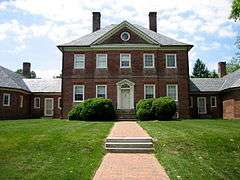

In colonial Delaware, Georgia, Maryland, North Carolina, South Carolina, and Virginia, the earliest plantation houses tended to follow British-derived folk forms such as the hall and parlor house-type and central-passage house-type.[9]
Grander structures during the later colonial period usually conformed to the neoclassically-influenced Georgian and Palladian styles, although some very early and rare Jacobean structures survive in Virginia. Following the Revolutionary War, Federal and Jeffersonian-type neoclassicism became dominant in formal plantation architecture.[10]
Large portions of the South outside of the original British colonies, such as in Kentucky and Tennessee, did not see extensive settlement until the early 1800s. Although large portions of Alabama and Mississippi were settled at roughly the same time, there were areas of these states, along with portions of western Georgia and southeastern Tennessee, that did not see wide-scale settlement until after the Indian removal in the 1830s. Very little formal architecture existed within these newly settled areas, with most dwellings being of hewn logs into the 1840s. The dogtrot-type plan was common for many of these log houses.[7]
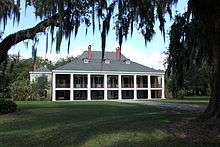
Rough vernacular architecture for early plantations was also true in Arkansas and Missouri although in their river regions, and in the southern portion of what became the state of Louisiana, the plantations reflected French Colonial architectural types, often with Spanish influences, well after the Louisiana Purchase in 1803. Admitted to the Union in the mid-1840s, early architecture in Florida and Texas generally showed a stronger Spanish Colonial architectural influence, blended with French and British forms.[5]
Some of the wealthiest planters never built grand residences. One example was noted by Albert J. Pickett, an early Alabama historian. In 1850 he visited Nicholas Davis, the owner of the prosperous Walnut Grove Plantation. Despite owning more than 100 slaves, he was still living in the large log house he had built after his migration from Virginia in 1817. He told Pickett that he "would not exchange (it) for a palace." Even Gaineswood, now a National Historic Landmark due to it being considered a lavish example of a plantation house, began as a two-story hewn-log dogtrot that was eventually enveloped within the brick mass of the house.[7][11]

After the period of initial settlement, more refined folk house types came from the older portions of the South, especially the I-house, thought by architectural scholars to be a descendant of the hall and parlor and the central-passage house-types.[12] The central-passage house continued to be popular and could be either single-pile (one room deep) or double-pile (two rooms deep).[12] If it had a porch, it was under a separate roof attached to the main house.[13]
I-houses were always two-stories high, always single-pile, with side gables or a hipped roof. They were at least two rooms wide, with latter examples usually having a central hall dividing them. In the South, they usually had full-width one-story shed extensions to the front and rear. These sheds could manifest as open porches, enclosed rooms, or a combination of the two. This I-house with sheds came to be commonly referred to as "Plantation Plain." It also proved to be one of the most adaptable folk house types to changing architectural tastes, with some even having neoclassical porticoes and other high-style elements added to them at a later date.[13]

Another house type, the Creole cottage, came from the areas along the Gulf Coast and its associated rivers that were formerly part of New France. It was always one-and-a-half stories, with a side-gabled roof, and often had upper floor dormer windows. However, it accommodated a full-width front porch under the main roof, with doors or jib-windows opening from all of the rooms onto the porch, and was usually raised high above the ground on a full raised basement or piers. It was a common form for many early plantation houses and town houses alike in the lower reaches of Alabama, Louisiana, and Mississippi.[13]
When the cotton boom years began in the 1830s, the United States was entering its second neoclassical phase, with Greek Revival architecture being the dominant style. By this point trained architects were also becoming more common, and several introduced the style to the South. Whereas the earlier Federal and Jeffersonian neoclassicism displayed an almost feminine lightness, academic Greek Revival was very masculine, with a heaviness not seen in the earlier styles.[15]

Earlier neoclassicism had often used ancient Roman models and the Tuscan order, along with the Roman versions of the original three Greek orders. The original Greek orders were Doric, Ionic, and the Corinthian. The academic version of Greek Revival embraced the pure form of ancient Grecian architecture. Due to its popularity during a time of great wealth for many southern plantations, it was the Greek Revival that became permanently linked to the plantation legend. Though some houses were architect-designed, many, if not most, were designed by the owners or their carpenters from pattern books published by Asher Benjamin, Minard Lafever, John Haviland, and others. Greek Revival proved to very adaptable to the hot and humid climate of the South, with colloquial adaptations of the style seen from one region, and sometimes from one town, to another.[15][16]
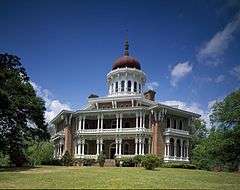
Greek Revival would remain a favorite architectural style in the agrarian South until well after the Civil War, but other styles had appeared in the nation about the same time as Greek Revival or soon afterward. These were primarily the Italianate and Gothic Revival.[17] They were slower to be adopted in whole for domestic plantation architecture, but they can be seen in a fusion of stylistic influences. Houses that were basically Greek Revival in character sprouted Italianate towers, bracketed eaves, or adopted the asymmetrical massing characteristic of that style.[15]
Although never as popular as Greek Revival, fully Gothic Revival and Italianate plantation houses began to appear by the 1850s, after being popularized by the books of men such as Alexander Jackson Davis, Andrew Jackson Downing, and Samuel Sloan. The Gothic Revival was usually expressed in wood as Carpenter Gothic. Italianate was the most popular of the two styles. It was also most commonly built using wood construction when used for plantation houses, although a few brick examples, such as Kenworthy Hall, have survived.[18]
The outbreak of war in 1861 put an abrupt end to the building of grand mansions. Following the war and the end of Reconstruction, the economy was drastically altered.[18] Planters often did not have the funds for upkeep of their existing houses and new construction virtually ceased on most plantations. The new sharecropping method kept many plantations going, but the days of extravagance were over.[5]
Slave quarters
.jpg)
Slave housing, although once one of the most common and distinctive features of the plantation landscape, has largely disappeared from most of the South. Many were insubstantial to begin with.[19] Only the better-built examples tended to survive, and then usually only if they were re-purposed for other uses after emancipation. Slave quarters could be adjacent to the main house, well away from it, or both. On large plantations they were often arranged in a village-like grouping along an avenue away from the main house, but sometimes were scattered around the plantation on the edges of the fields where the slaves toiled, like most of the sharecropper cabins that were to come later.[20]
Slave houses were often one of the most basic construction. Meant for little more than sleeping, they were usually rough log or frame one-room cabins; early examples often had chimneys made of clay and sticks.[19][21] Hall and parlor houses (two rooms) were also represented on the plantation landscape, offering a separate room for eating and sleeping. Sometimes dormitories and two-story dwellings were also used as slave housing. Earlier examples rested on the ground with a dirt floor, but later examples were usually raised on piers for ventilation. Most of these represent the dwellings constructed for field slaves. Rarely though, such as at the former Hermitage Plantation in Georgia and Boone Hall in South Carolina, even field slaves were provided with brick cabins.[22]
More fortunate in their accommodations were the house servants or skilled laborers. They usually resided either in a part of the main house or in their own houses, which were normally more comfortable dwellings than those of their counterparts who worked in the fields.[21][22] A few slave owners went even further to provide housing for their household servants. When Waldwic in Alabama was remodeled in the Gothic Revival style in the 1852, the household servants were provided with large accommodations that matched the architecture of the main house. This model, however, was exceedingly rare.[7]

Famous landscape designer Frederick Law Olmsted had this recollection of a visit to plantations along the Georgia coast in 1855:
In the afternoon, I left the main road, and, towards night, reached a much more cultivated district. The forest of pines extended uninterruptedly on one side of the way, but on the other was a continued succession of very large fields, or rich dark soil – evidently reclaimed swamp-land – which had been cultivated the previous year, in Sea Island cotton, or maize. Beyond them, a flat surface of still lower land, with a silver thread of water curling through it, extended, Holland-like, to the horizon. Usually at as great a distance as a quarter of a mile from the road, and from a half mile to a mile apart, were the residences of the planters – large white houses, with groves of evergreen trees about them; and between these and the road were little villages of slave-cabins…The cottages were framed buildings, boarded on the outside, with shingle roofs and brick chimneys; they stood fifty feet apart, with gardens and pig-yards…At the head of the settlement, in a garden looking down the street, was an overseer's house, and here the road divided, running each way at right angles; on one side to barns and a landing on the river, on the other toward the mansion...— Frederick Law Olmsted, A Journey in the Seaboard Slave States[23]
Other residential structures
A crucial residential structure on larger plantations was an overseer's house. The overseer was largely responsible for the success or failure of an estate, making sure that quotas were met and sometimes meting out justice for infractions by the enslaved. The overseer was responsible for healthcare, with slaves and slave houses inspected routinely. He was also the record keeper of most crop inventories and held the keys to various storehouses.[24]

The overseer's house was usually a modest dwelling, not far from the slave cabins. The overseer and his family, even when white and southern, did not freely mingle with the planter and his family. They were in a different social stratum than that of the owner and were expected to know their place. In village-type slave quarters on plantations with overseers, his house was usually at the head of the slave village rather than near the main house, at least partially due to his social position. It was also part of an effort to keep the slave population compliant and prevent the beginnings of a slave rebellion, a very real fear in the minds of most plantation owners.[24]
Economic studies indicate that fewer than 30 percent of planters employed white supervisors for their slave labor.[25] Some planters appointed a trusted slave as the overseer, and in Louisiana free black overseers were also used.[24]
Another residential structure largely unique to plantation complexes was the garconnière or bachelors' quarters. Mostly built by Louisiana Creole people, but occasionally found in other parts of the Deep South formerly under the dominion of New France, they were structures that housed the adolescent or unmarried sons of plantation owners. At some plantations it was a free-standing structure and at others it was attached to the main house by side-wings. It developed from the Acadian tradition of using the loft of the house as a bedroom for young men.[26]
Kitchen yard
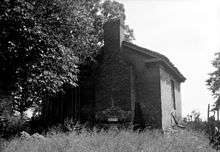
A variety of domestic and lesser agricultural structures surrounded the main house on all plantations. Most plantations possessed some, if not all, of these outbuildings, often called dependencies, commonly arranged around a courtyard to the rear of the main house known as the kitchen yard. They included a cookhouse (separate kitchen building), pantry, washhouse (laundry), smokehouse, chicken house, spring house or ice house, milkhouse (dairy), covered well, and cistern. The privies would have been located some distance away from the plantation house and kitchen yard.[27]
The cookhouse or kitchen was almost always in a separate building in the South until modern times, sometimes connected to the main house by a covered walkway. This separation was partially due to the cooking fire generating heat all day long in an already hot and humid climate. It also reduced the risk of fire. Indeed, on many plantations the cookhouse was built of brick while when the main house was of wood-frame construction. Another reason for the separation was to prevent the noise of cooking activities from reaching the main house. Sometimes the cookhouse contained two rooms, one for the actual kitchen and the other to serve as the residence for the cook. Still other arrangements had the kitchen in one room, a laundry in the other, and a second story for servant quarters.[7][27] The pantry could be in its own structure or in a cool part of the cookhouse or a storehouse and would have secured items such as barrels of salt, sugar, flour, cornmeal and the like.[28]
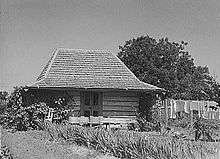
The washhouse is where clothes, tablecloths, and bed-covers were cleaned and ironed. It also sometimes had living quarters for the laundrywoman. Cleaning laundry in this period was labor-intensive for the domestic slaves that performed it. It required various gadgets to accomplish the task. The wash boiler was a cast iron or copper cauldron in which clothes or other fabrics and soapy water were heated over an open fire. The wash-stick was a wooden stick with a handle at its uppermost part and four to five prongs at its base. It was simultaneously pounded up and down and rotated in the washing tub to aerate the wash solution and loosen any dirt. The items would then be vigorously rubbed on a corrugated wash board until clean. By the 1850s, they would be passed through a mangle. Prior to that time, wringing out the items was done by hand. The items would then be ready to be hung out to dry or, in inclement weather, placed on a drying rack. Ironing would have been done with a metal flat iron, often heated in the fireplace, and various other devices.[29]

The milkhouse would have been used by slaves to make milk into cream, butter, and buttermilk. The process started with separating the milk into skim milk and cream. It was done by pouring the whole milk into a container and allowing the cream to naturally rise to the top. This was collected into another container daily until several gallons had accumulated. During this time the cream would sour slightly through naturally occurring bacteria. This increased the efficiency of the churning to come. Churning was an arduous task performed with a butter churn. Once firm enough to separate out, but soft enough to stick together, the butter was taken out of the churn, washed in very cold water, and salted. The churning process also produced buttermilk as a by-product. It was the remaining liquid after the butter was removed from the churn.[30] All of the products of this process would have been stored in the spring house or ice house.[27]

The smokehouse was utilized to preserve meat, usually pork, beef, and mutton. It was commonly built of hewn logs or brick. Following the slaughter in the fall or early winter, salt and sugar were applied to the meat at the beginning of the curing process, and then the meat was slowly dried and smoked in the smokehouse by a fire that did not add any heat to the smokehouse itself.[31] If it was cool enough, the meat could also be stored there until it was consumed.[27]
The chicken house was a building where chickens were kept. Its design could vary, depending on whether the chickens were kept for egg production, meat, or both. If for eggs, there were often nest boxes for egg laying and perches on which the birds to sleep. Eggs were collected daily.[27] Some plantations also had pigeonniers (dovecotes) that, in Louisiana, sometimes took the form of monumental towers set near the main house. The pigeons were raised to be eaten as a delicacy and their droppings were used as fertilizer.[32]
Few functions could take place on a plantation without a reliable water supply. Every plantation had at least one, and sometimes several, wells. These were usually roofed and often partially enclosed by latticework to keep out animals. Since the well water in many areas was distasteful due to mineral content, the potable water on many plantations came from cisterns that were supplied with rainwater by a pipe from a rooftop catchment. These could be huge aboveground wooden barrels capped by metal domes, such as was often seen in Louisiana and coastal areas of Mississippi, or underground brick masonry domes or vaults, common in other areas.[7][33]
Ancillary structures

Some structures on plantations provided subsidiary functions; again, the term dependency can be applied to these buildings. A few were common, such as the carriage house and blacksmith shop; but most varied widely among plantations and were largely a function of what the planter wanted, needed, or could afford to add to the complex. These buildings might include schoolhouses, offices, churches, commissary stores, gristmills, and sawmills.[7][34]
Found on some plantations in every southern state, plantation schoolhouses served as a place for the hired tutor or governess to educate the planter's children, and sometimes even those of other planters in the area.[7] On most plantations, however, a room in the main house was sufficient for schooling, rather than a separate dedicated building. Paper was precious, so the children often recited their lessons until they memorized them. The usual texts in the beginning were the Bible, a primer, and a hornbook. As the children grew older their schooling began to prepare them for their adult roles on the plantation. Boys studied academic subjects, proper social etiquette, and plantation management, while girls learned art, music, French, and the domestic skills suited to the mistress of a plantation.[35]
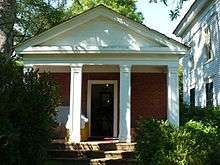
Most plantation owners maintained an office for keeping records, transacting business, writing correspondence, and the like.[7] Although it, like the schoolroom, was most often within the main house or another structure, it was not at all rare for a complex to have a separate plantation office. John C. Calhoun used his plantation office at his Fort Hill plantation in Clemson, South Carolina as a private sanctuary of sorts, with it utilized as both study and library during his twenty-five year residency.[36]
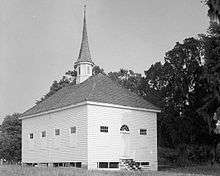
Another structure found on some estates was a plantation chapel or church. These were built for a variety of reasons. In many cases the planter built a church or chapel for the use of the plantation slaves, although they usually recruited a white minister to conduct the services.[37] Some were built to exclusively serve the plantation family, but many more were built to serve the family and others in the area who shared the same faith. This seems to be especially true with planters within the Episcopal denomination. Early records indicate that at Faunsdale Plantation the mistress of the estate, Louisa Harrison, gave regular instruction to her slaves by reading the services of the church and teaching the Episcopal catechism to their children. Following the death of her first husband, she had a large Carpenter Gothic church built, St. Michael's Church. She latter remarried to Rev. William A. Stickney, who served as the Episcopal minister of St. Michael's and was later appointed by Bishop Richard Wilmer as a "Missionary to the Negroes," after which Louisa joined him as an unofficial fellow minister among the African Americans of the Black Belt.[38]

Most plantation churches were of wood-frame construction, although some were built in brick, often stuccoed. Early examples tended towards the vernacular or neoclassicism, but later examples were almost always in the Gothic Revival style. A few rivaled those built by southern town congregations. Two of the most elaborate extant examples in the Deep South are the Chapel of the Cross at Annandale Plantation and St. Mary's Chapel at Laurel Hill Plantation, both Episcopalian structures in Mississippi. In both cases the original plantation houses have been destroyed, but the quality and design of the churches can give some insight into how elaborate some plantation complexes and their buildings could be. St. Mary Chapel, in Natchez, dates to 1839, built in stuccoed brick with large Gothic and Tudor arch windows, hood mouldings over the doors and windows, buttresses, a crenelated roof-line, and a small Gothic spire crowning the whole.[39] Although construction records are very sketchy, the Chapel of the Cross, built from 1850–1852 near Madison, may be attributable to Frank Wills or Richard Upjohn, both of whom designed almost identical churches in the North during the same time period that the Chapel of the Cross was built.[40][41]

Another secondary structure on many plantations during the height of the sharecropping-era was the plantation store or commissary. Although some antebellum plantations had a commissary that distributed food and supplies to slaves, the plantation store was essentially a postbellum addition to the plantation complex. In addition to the share of their crop already owed to the plantation owner for the use of his or her land, tenants and sharecroppers purchased, usually on credit against their next crop, the food staples and equipment that they relied on for their existence.[7][42]
Planters maintained a record of the purchases, often adding exorbitant interest rates. A 1909 estimate by the Department of Agriculture concluded that the average sharecropper cleared only about $175 from his crops before settling his accounts at the plantation store. However, afterward the tenant farmer had to pay for the coming year's staples, thereby keeping himself permanently indebted to the plantation owner.
This type of debt bondage, for blacks and poor whites, led to a populist movement in the late 19th century that began to bring blacks and whites together for a common cause. This early populist movement is largely credited with helping to cause state governments in the South, mostly controlled by the planter elite, to enact various laws that disenfranchised poor whites and blacks, through grandfather clauses, literacy tests, poll taxes, and various other laws.[42]
Agricultural structures
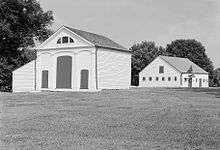
The agricultural structures on plantations had some basic structures in common and others that varied widely. They depended on what crops and animals were raised on the plantation. Common crops included corn, upland cotton, sea island cotton, rice, sugarcane, and tobacco. Besides those mentioned earlier, cattle, ducks, goats, hogs, and sheep were raised for their derived products and/or meat. All estates would have possessed various types of animal pens, stables, and a variety of barns. Many plantations utilized a number of specialized structures that were crop-specific and only found on that type of plantation.[43]
Plantation barns can be classified by function, depending on what type of crop and livestock were raised.[44] In the upper South, like their counterparts in the North, barns had to provide basic shelter for the animals and storage of fodder. Unlike the upper regions, most plantations in the lower South did not have to provide substantial shelter to their animals during the winter. Animals were often kept in fattening pens with a simple shed for shelter, with the main barn or barns being utilized for crop storage or processing only.[43] Stables were an essential type of barn on the plantation, used to house both horses and mules. These were usually separate, one for each type of animal. The mule stable was the most important on the vast majority of estates, since the mules did most of the work, pulling the plows and carts.[43]

Barns not involved in animal husbandry were most commonly the crib barn (corn cribs or other types of granaries), storage barns, or processing barns. Crib barns were typically built of unchinked logs, although they were sometimes covered with vertical wood siding. Storage barns often housed unprocessed crops or those awaiting consumption or transport to market. Processing barns were specialized structures that were necessary for helping to actually process the crop.[44]
Tobacco plantations were most common in certain parts of Georgia, Florida, Kentucky, Missouri, North Carolina, Tennessee, South Carolina, and Virginia. The first agricultural plantations in Virginia were founded on the growing of tobacco. Tobacco production on plantations was very labor-intensive. It required the entire year to gather seeds, start them growing in cold frames, and then transplant the plants to the fields once the soil had warmed. Then the slaves had to weed the fields all summer and remove the flowers from the tobacco plants in order to force more energy into the leaves. Harvesting was done by plucking individual leaves over several weeks as they ripened. The leaves were then hung in the vented tobacco barn to cure them.[45][46]

Rice plantations were common in the South Carolina Lowcountry. Until the 19th century, rice was threshed from the stalks and the husk was pounded from the grain by hand, a very labor-intensive endeavor. Steam-powered rice pounding mills had become common by the 1830s. They were used to thresh the grain from the inedible chaff. A separate chimney, required for the fires powering the steam engine, was adjacent to the pounding mill and often connected by an underground system. The winnowing barn, a building raised roughly a story off of the ground on posts, was used to separate the lighter chaff and dust from the rice.[47][48]
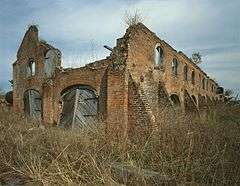
Sugar plantations were most commonly found in Louisiana. In fact, Louisiana produced almost all of the sugar grown in the United States during the antebellum period. From one-quarter to one-half of all sugar consumed in the United States came from Louisiana sugar plantations. Plantations grew sugarcane from Louisiana's colonial era onward, but large scale production did not begin until the 1810s and 1820s. A successful sugar plantation required a skilled retinue of hired labor and slaves.[49]
The most specialized structure on a sugar plantation was the sugar mill (sugar house), where, by the 1830s, the steam-powered mill crushed the sugarcane stalks between rollers. This squeezed the juice from the stalks and the cane juice would run out the bottom of the mill through a strainer to be collected into a tank. From there the juice went through a process that removed impurities from the liquid and thickened it through evaporation. It was steam-heated in vats where additional impurities were removed by adding lime to the syrup and then the mixture was strained. At this point the liquid had been transformed into molasses. It was then placed into a closed vessel known as a vacuum pan, where it was boiled until the sugar in the syrup was crystallized. The crystallized sugar was then cooled and separated from any remaining molasses in a process known as purging. The final step was packing the sugar into hogshead barrels for transport to market.[50]
%2C_Tarboro_(Edgecombe_County%2C_North_Carolina).jpg)
Cotton plantations, the most common type of plantation in the South prior to the Civil War, were the last type of plantation to fully develop. Cotton production was a very labor-intensive crop to harvest, with the fibers having to be hand-picked from the bolls. This was coupled with the equally laborious removal of seeds from fiber by hand.[51]
Following the invention of the cotton gin, cotton plantations sprang up all over the South and cotton production soared, along with the expansion of slavery. Cotton also caused plantations to grow in size. During the financial panics of 1819 and 1837, when demand by British mills for cotton dropped, many small planters went bankrupt and their land and slaves were bought by larger plantations. As cotton-producing estates grew in size, so did the number of slaveholders and the average number of slaves held.[1][51]
A cotton plantation normally had a cotton gin house, where the cotton gin was used to remove the seeds from raw cotton. After ginning, the cotton had to be baled before it could be warehoused and transported to market. This was accomplished with a cotton press, an early type of baler that was usually powered by two mules walking in a circle with each attached to an overhead arm that turned a huge wooden screw. The downward action of this screw compressed the processed cotton into a uniform bale-shaped wooden enclosure, where the bale was secured with twine.[52]
See also
- Slavery in the United States
- Sharecropping in the United States
- Casa-Grande & Senzala (similar concept in Brazilian plantations)
- Plantations of Leon County (Florida)
References
- 1 2 Sellers, James Benson (1950). Slavery in Alabama. Tuscaloosa: University of Alabama Press. pp. 19–43. ISBN 0-8173-0594-7.
- 1 2 Phillips, Ulrich Bonnell (1929). Life and Labor in the Old South. Boston: Little, Brown, and Company. p. 338. ISBN 978-0-316-70607-0.
- ↑ Robert J. Vejnar II (November 6, 2008). "Plantation Agriculture". The Encyclopedia of Alabama. Auburn University. Retrieved April 15, 2011.
- 1 2 Vlach, John Michael (1993). Back of the Big House, The Architecture of Plantation Slavery. Chapel Hill: University of North Carolina Press. p. 8. ISBN 978-0-8078-4412-0.
- 1 2 3 4 5 6 7 Matrana, Marc R. (2009). Lost Plantations of the South. Jackson: University Press of Mississippi. pp. xi–xv. ISBN 978-1-57806-942-2.
- ↑ Edwards, Jay Dearborn; Nicolas Kariouk Pecquet du Bellay de Verton (2004). A Creole lexicon: Architecture, Landscape, People. Baton Rouge: Louisiana State University Press. pp. 153–157. ISBN 978-0-8071-2764-3.
- 1 2 3 4 5 6 7 8 9 10 11 Robert Gamble (September 2, 2008). "Plantation Architecture in Alabama". The Encyclopedia of Alabama. Auburn University. Retrieved April 15, 2011.
- ↑ Kristen Merryman; Sarah Rice Scott (2010). "Architecture in North Carolina: an overview". NCpedia. State Library of North Carolina. Retrieved April 15, 2011.
- ↑ Williams, Kimberly Prothro (2003). A Pride of Place: Rural Residences of Fauquier County, Virginia. Charlottesville: University of Virginia Press. pp. 19–22. ISBN 978-0-8139-1997-3.
- ↑ Whiffen, Marcus; Frederick Koeper (1983). American Architecture, Volume 1: 1607–1860. Cambridge, Massachusetts: The MIT Press. pp. 53–124. ISBN 0-262-73069-3.
- ↑ Gamble, Robert (1990). Historic architecture in Alabama: a guide to styles and types, 1810-1930. Tuscaloosa: University of Alabama Press. p. 76. ISBN 0-8173-1134-3.
- 1 2 Foster, Gerald L. (2004). American Houses: A Field Guide to the Architecture of the Home. Boston: Houghton Mifflin Harcourt. pp. 94–96. ISBN 978-0-618-38799-1.
- 1 2 3 Gamble, Robert (1990). Historic architecture in Alabama: a guide to styles and types, 1810-1930. Tuscaloosa: University of Alabama Press. pp. 29–40. ISBN 0-8173-1134-3.
- ↑ Jenrette, Richard Hampton (2005). Adventures with Old Houses, p. 179. Wyrick & Company.
- 1 2 3 Gamble, Robert (1990). Historic architecture in Alabama: a guide to styles and types, 1810-1930. Tuscaloosa: University of Alabama Press. pp. 57–79. ISBN 0-8173-1134-3.
- ↑ Whiffen, Marcus; Frederick Koeper (1983). American Architecture, Volume 1: 1607–1860. Cambridge, Massachusetts: The MIT Press. pp. 159–178. ISBN 0-262-73069-3.
- ↑ Whiffen, Marcus; Frederick Koeper (1983). American Architecture, Volume 1: 1607–1860. Cambridge, Massachusetts: The MIT Press. pp. 179–198. ISBN 0-262-73069-3.
- 1 2 Gamble, Robert (1990). Historic architecture in Alabama: a guide to styles and types, 1810-1930. Tuscaloosa: University of Alabama Press. pp. 85–105. ISBN 0-8173-1134-3.
- 1 2 Thomas E. Davidson. "The Evolution of the Slave Quarter in Tidewater Virginia". Jamestown Settlement and Yorktown Victory Center. Jamestown-Yorktown Foundation. Retrieved April 15, 2011.
- ↑ Vlach, John Michael (1993). Back of the Big House, The Architecture of Plantation Slavery. Chapel Hill: University of North Carolina Press. pp. 10,12,192. ISBN 978-0-8078-4412-0.
- 1 2 Mark Watson. "Slave Housing". Slave Housing in Montgomery County. Montgomery County Historical Society. Retrieved April 15, 2011.
- 1 2 Vlach, John Michael (1993). Back of the Big House, The Architecture of Plantation Slavery. Chapel Hill: University of North Carolina Press. pp. 155–159. ISBN 978-0-8078-4412-0.
- ↑ Olmsted, Frederick Law (1968). A Journey in the Seaboard Slave States. New York: Negro University Press. pp. 416–417.
- 1 2 3 "Overseer's House at the Rural Life Museum" (PDF). Rural Life Museum. Louisiana State University. Retrieved April 15, 2011.
- ↑ Catherine Clinton. "The Southern Plantation". Macmillan Information Now Encyclopedia. Civil War Potpourri. Retrieved April 15, 2011.
- ↑ Edwards, Jay Dearborn; Nicolas Kariouk Pecquet du Bellay de Verton (2004). A Creole lexicon: Architecture, Landscape, People. Baton Rouge: Louisiana State University Press. p. 107. ISBN 978-0-8071-2764-3.
- 1 2 3 4 5 Mary, Gunderson (2000). Southern Plantation Cooking. Mankato, Minn: Blue Earth Books. p. 10. ISBN 978-0-7368-0357-1.
- ↑ Pond, Catherine Seiberling (2007). The Pantry: Its History and Modern Uses. Layton, Utah: Gibbs Smith. p. 23. ISBN 978-1-4236-0004-6.
- ↑ Gaeta Bell. "Laundry in the 19th Century" (PDF). East Bay Regional Park District. Retrieved April 15, 2011.
- ↑ David B. Fankhauser. "Making Buttermilk". University of Cincinnati Clermont College. Retrieved April 15, 2011.
- ↑ Judith Quinn. "Mechanics and Functions of a Smokehouse" (PDF). University of Delaware Library. Retrieved April 15, 2011.
- ↑ "French Creole Architecture". Louisiana Division of Historic Preservation. National Park Service. Retrieved April 15, 2011.
- ↑ Rodriguez, Junius P. (2007). Slavery in the United States: A social, political, and historical encyclopedia, Volume 2. Santa Barbara, Calif: ABC-CLIO. p. 671. ISBN 978-1-85109-544-5.
- ↑ Roberts, Bruce; Elizabeth Kedash (1990). Plantation homes of the James River. Chapel Hill: University of North Carolina Press. pp. 4–6. ISBN 978-0-8078-4278-2.
- ↑ "Colonial Education". Stratford Hall Plantation. Robert E. Lee Memorial Association, Inc., Stratford Hall. Retrieved April 15, 2011.
- ↑ "Fort Hill Plantation Office". South Carolina Historical Society. The Historical Marker Database. Retrieved April 15, 2011.
- ↑ Diana J. Kleiner. "Waldeck Plantation". Texas State Historical Association. Retrieved April 15, 2011.
- ↑ "Faunsdale Plantation Papers, 1805-1975" (PDF). Department of Archives and Manuscripts. Birmingham Public Library. Retrieved April 15, 2011.
- ↑ "St. Mary Chapel, located on Laurel Hill Plantation in Adams County, approximately eight (8) miles south of Natchez. This property was an English land grant to the Richard Ellis family and continues to be owned by his descendants. {Note that there is also a Laurel Hill Plantation in Jefferson County that was owned by the Rush Nutt family}". St. Mary Basilica Archives. Episcopal Diocese of Jackson: St. Mary Basilica Archives. Retrieved April 15, 2011.
- ↑ "History of The Chapel of the Cross". Chapel of the Cross. Retrieved April 15, 2011.
- ↑ "Chapel Of The Cross". Mississippi Department of Archives and History. Retrieved April 15, 2011.
- 1 2 Whayne, Jeannie M. (1990). A New Plantation South: Land, Labor, and Federal Favor in Twentieth-century Arkansas. Charlottesville: University of Virginia Press. pp. 55–57. ISBN 978-0-8139-1655-2.
- 1 2 3 Poesch, Jessie J.; Barbara SoRelle Bacot (1997). Louisiana Buildings, 1720-1940: The Historic American Buildings Survey. Baton Rouge: LSU Press. pp. 157–165. ISBN 978-0-8071-2054-5.
- 1 2 "The Preservation of Historic Barns". National Park Service. Retrieved April 15, 2011.
- ↑ Hart, John Fraser; Mather, Eugene Cotton (September 1961). "The Character of Tobacco Barns and Their Role in the Tobacco Economy of the United States". Annals of the Association of American Geographers. 51 (3): 274–293. doi:10.1111/j.1467-8306.1961.tb00379.x.
- ↑ "Tobacco and Staple Agriculture". Tobacco in Virginia. Virginia Places. Retrieved April 15, 2011.
- ↑ "Georgetown County Rice Culture, c. 1750-c. 1910" (PDF). National Register of Historic Places. National Park Service. Retrieved April 15, 2011.
- ↑ Rob Martin. "The Farming and Processing of Rice". Isle of Wight History Centre. Retrieved April 15, 2011.
- ↑ "Antebellum Louisiana: Agrarian Life". The Cabildo: Two Centuries of Louisiana History. Louisiana State Museum. Retrieved April 16, 2011.
- ↑ "Sugarhouse and Sugar Production at Ashland". Beyond The Great House: Archaeology at Ashland-Belle Helene Plantation. Louisiana Division of Archaeology. Retrieved April 16, 2011.
- 1 2 Jean M. West. "King Cotton: The Fiber of Slavery". Encyclopedia of Slavery in America. Retrieved April 16, 2011.
- ↑ "The Cotton Press". Africans in America. Public Broadcasting Service. Retrieved April 15, 2011.